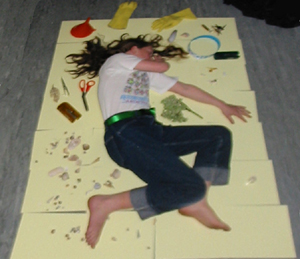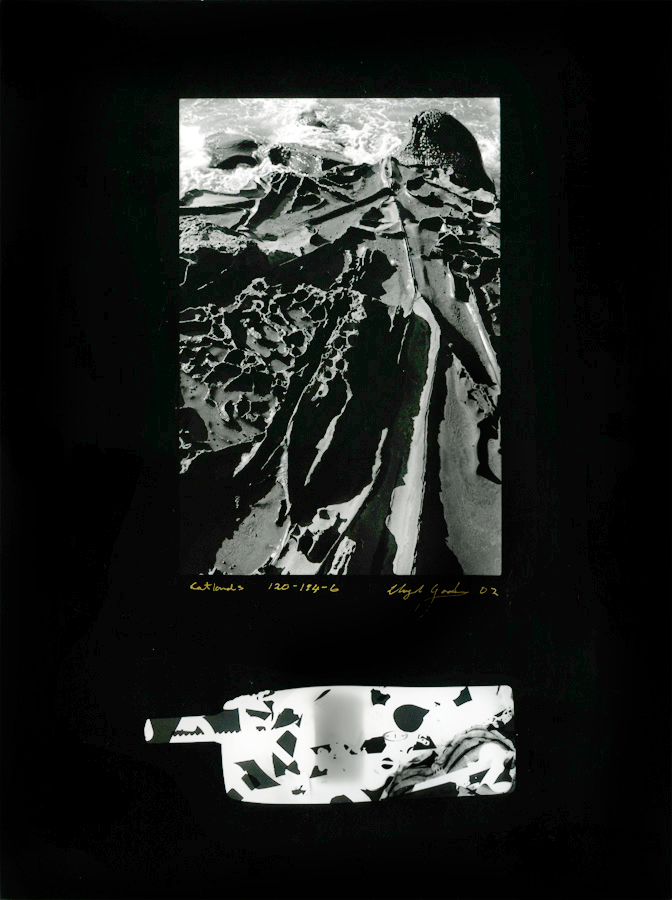Light
Sources to create photograms
The relative sharpness of the shadow cast on the paper by
an object and the corresponding image is dependent upon the
nature of the light source. A light focused through an enlarger
will produce a much different effect sharper shadow than the
soft light of a fluorescent tube. Also the size of the light
source an play a part in the shadow cast by the object.
--------------------------------------------------------------------------------
Although
enlargers are used to make most photograms, the process where
light is directed for a predetermined period of time at objects
laid on a light sensitive emulsion means that almost any light
source can be used. Because such a wide range of light sources
can be used, it means the technique can be used in a wide
range of situations
In
some situations care make need to be taken not to pre-fog
the material before the exposure. A special holder similar
to a cut film double dark slide or a light tight tube can
be used to transport the material to a location distant location.
Combinations of light sources can also be used.
--------------------------------------------------------------------------------
Some
light sources that can be used to make photograms
Sun light -
This is often the main source of light used for many alternative
processes like the Cyanotype, Van Dyke Brown, or printing
out paper, or platinum paper but it can also be used to make
photosynthetic photograms on grass or the leaves of plants.
UV lamps can also be used for some of these processes.
Fluorescent
Tubes. -
The colour of Fluorescent tubes varies but the light quality
is usually consistently soft and indirect.
Neon
Lights - These vary in colour and intensity.
Flash lights - (Strobe Lights)
These can either be small hand held units, studio flashes,
or even attached to a camera. When working with colour materials
colour filters can be placed over the front of the flash unit.
I have made large photograms with 3-4 people laid on the paper
during a photogram workshop I ran with Peter Fitzpatrick from
Sydney Australia.

Mouse
over
I have also used an on camera flash to both record the process
and make the exposure during a photogram workshop.
Thomas Barrow used this method for some of his work firing
the flash many times to penetrate dense materials.
Tungsten lights -
This includes a wide variety of readily available lights from
floods and spot lights to house hold bulbs. It includes room
lights desk lamps etc.
Quartz halogen -
Polarized
Light -
Photograms can be made with polarized light in a number of
ways.
A
piece of clear plastic will reveal another colour dimension
when placed between two polarizing filters with a light source
on one side and the sensitive paper on the other. The effect
works best with colour materials.
Torch
lights -
While portable torches vary from large units small pen lights,
light can be painted over the objects with a hand held torch
to expose specific parts of the image. In the case of Luminograms
the torch can be used to paint a light image on the paper.
Moon
Light-
With the right materials and experimentation it is even possible
to use the light from a full moon to make photograms.
Mobile phones - In this image I used the light from a mobile phone as part of this photogram image

LCD screen of a digital camera -
Ultra
Violet lights (Black lamps)-
Some materials transmit UV differently than light.
Street
light-
Street lighting can vary considerably from Fluorescent, mercury
vapor to sodium vapor, not all will produce sufficient light
to enable an urban exposure with some materials. For instance
low level sodium vapor light produce a very orange colour
which is fairly safe to black and white paper. I have used
a row sodium vapor street lights along a road by a beach as
a safe light to help set up photograms made by laying paper
in the ocean and exposing it with a flash light.
Magnesium
Powder-
This flash powder can be used to make photograms.
Projectors -
Slide, movie, OHp and Data projectors can be provide an excellent
source of focused light than can be projected from an extremely
oblique angle to the paper. For the Disturbance
in the field work, and the larger @ the Speed of Light, I use a projector to not only project
an image onto the photographic paper, but to develop the image
through the action of light.
Fire
-
Fire
works-
Television
Screens-
The light and radiation for a television screen can also be
used to create photograms
Candles
-
Lightening-
While it is hard to control, lightening can produce sufficient
light to enable an exposure
Anti
static guns-
static charges fired at the sensitive material can produce
unpredictable marks on the paper.
X-rays-
With the right materials and equipment, x-rays can be used
to make photogram images.
Chemical
light sticks-
Luminous
materials -
Luminous
creatures
|